Affiliate disclosure: This post may contain affiliate links. Please see our Privacy Policy.
Gooseberry jam is one of those old fashioned pleasures that your grandma raves about, but it’s hard to lay hands on it these days. Since gooseberries are making their way back into farmers markets across the country, it’s easy enough to make your own homemade gooseberry jam.
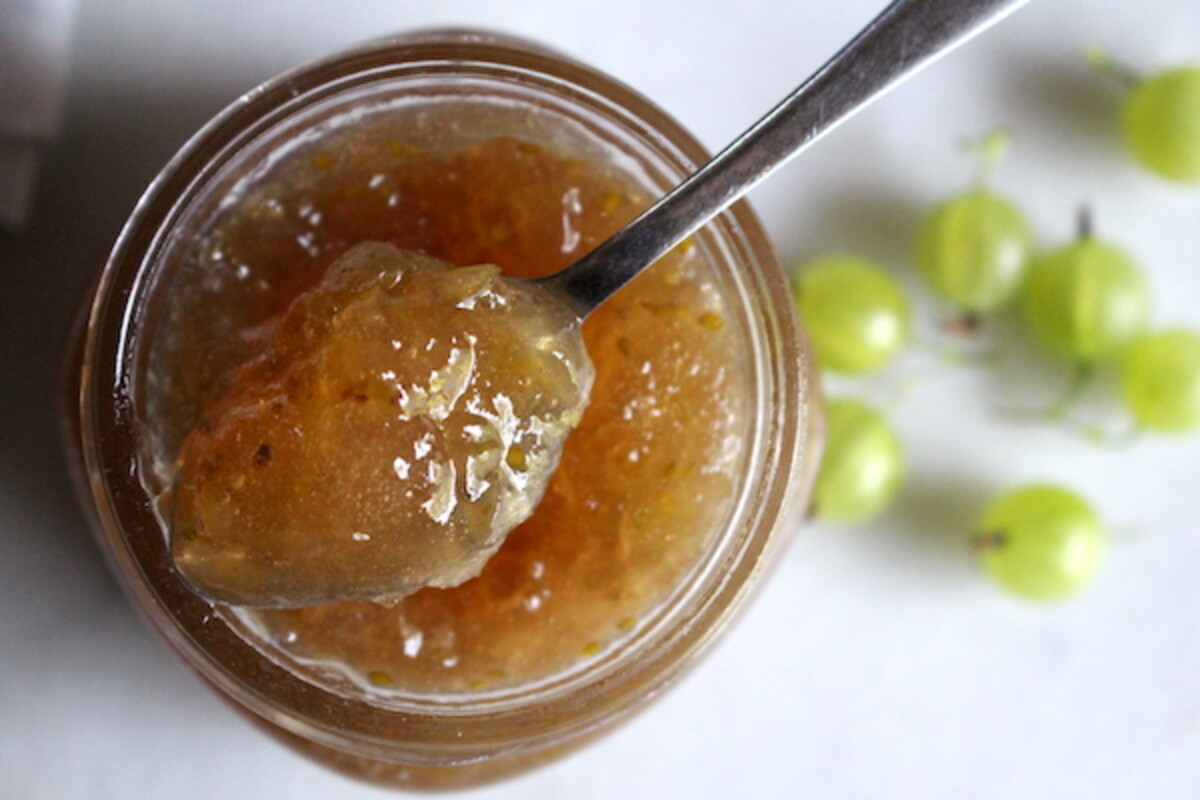
My husband raves about gooseberry jam, and he grew up eating it as a child in Oregon. They had huge gooseberry bushes in the back yard.
The plants are more commonly grown in England, and where they thrive in cool, wet weather and part shade. With its rainy climate, the pacific northwest isn’t much different and the bushes are dripping with fruit midsummer.
Three years ago we planted our own gooseberry bushes in the yard here in Vermont, and while they’ve born modest crops every year, this year has been consistently wet, cool and overcast.
I’ve been watching those little orbs develop on the gooseberry plants, and repeating over and over in a sing-songy voice, “There’s going to be gooseberry jam!” Add a bit of happy bouncing and you get the idea.
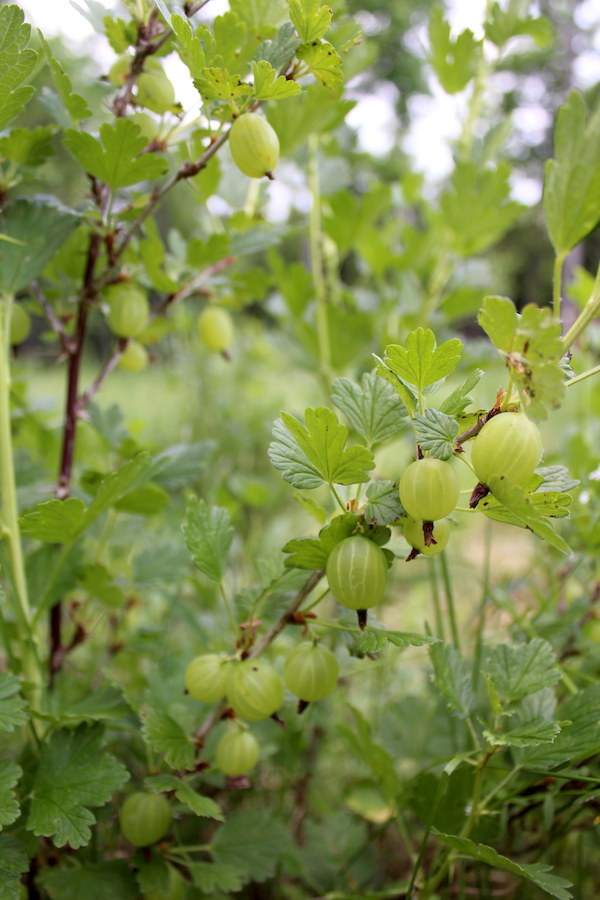
My four-year-old is a serious jam fiend, but she also loves fresh fruit. I told her we’re saving these beauties for a special gooseberry jam and convinced her to let the bushes be.
My two-year-old, on the other hand, is a different story. I’ll admit that I tricked him into believing that these are special berries just for geese, and he’s been watching them out the window waiting to see when the Canada geese will land to collect their prize.
A little bit of deception perhaps, but all in the name of gooseberry jam, so it’s worth it. He’ll thank me later…
In all his watching, not one goose, but this week alone we’ve seen a flock of turkeys, half a dozen deer, robins, and even a weasel. None of them touched the gooseberries, of course, they’re just for geese…
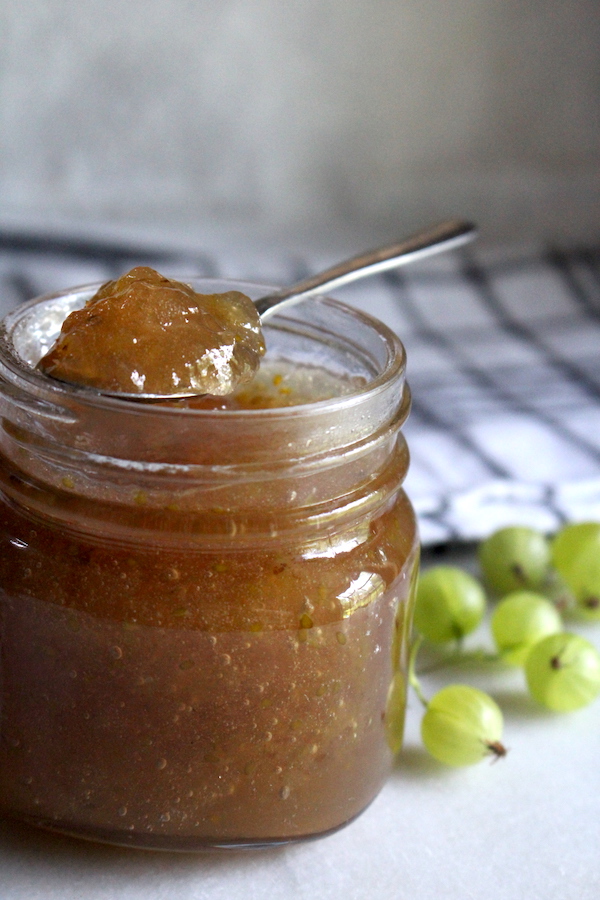
The crop was just about ripe, literally days away and all of them were still hanging heavy on the branches. Tomorrow, or the next day, I thought…it’s gooseberry jam day.
Of course, that’s when our free-ranging chickens got the memo that we were saving something special for another breed of poultry. Not to be outdone, they descended in mass and stripped the bottom foot of each bush in just minutes. My dutiful gooseberry observer cried fowl, and I ran out to chase them off, but they’d made away with the better part of the gooseberry harvest.
Luckily our bushes are pretty tall, and some of the fruit was saved. I managed to harvest just a single bowl of plump ripe gooseberries for my jam.
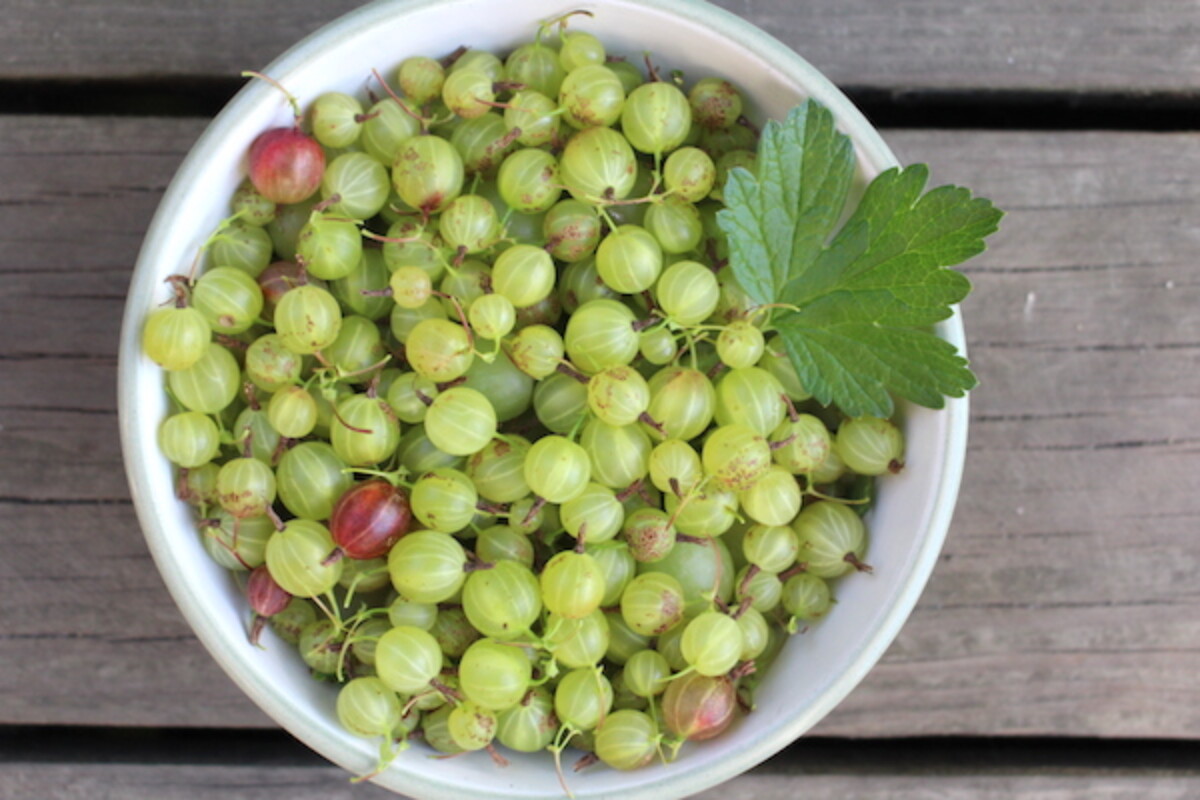
Gooseberries can be either red or green, and red gooseberries will yield a deep blood red jam similar to a red currant jam. (They are closely related after all.) In past years, the red gooseberries have been most of our harvest, as those bushes tend to bear more heavily on our land.
Unfortunately, they also tend to grow a bit shorter, and the bright red fruit makes them a lot easier to spot by greedy little gooseberry stealing chickens. I had hoped to make two batches, a bright red version, and a deep green version. No luck this year, but really it’s just cosmetic, and regardless of color, gooseberry jam tastes the same.
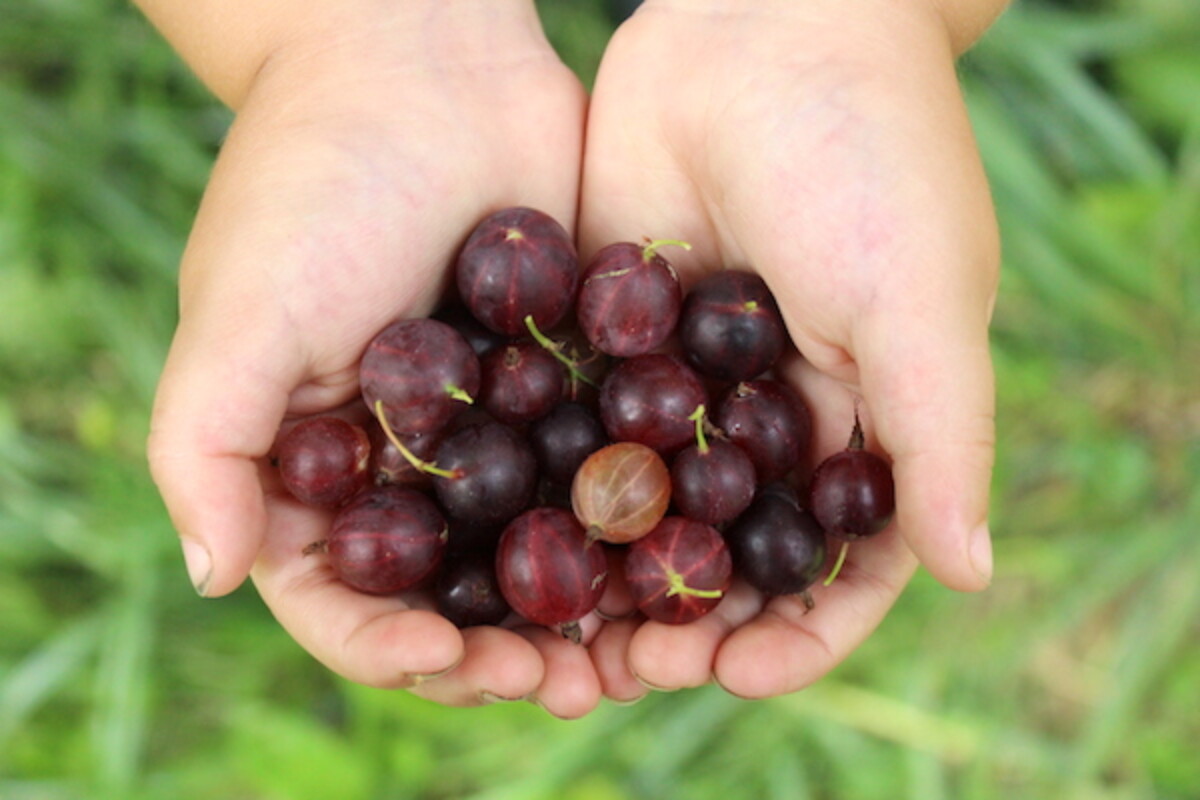
How to Make Gooseberry Jam
I fell victim to that age-old folly, count your gooseberries before they’re ripe, and started researching gooseberry jam recipes over a month ago. An old-fashioned fruit, I assumed it’d be a lot like making blackcurrant jam, with a long gradual boil before the jam reached gel stage. Not so!
Just the opposite in fact. Making gooseberry jam is absurdly simple, and fast.
They’re a high pectin fruit, which means you can make a thick, rich jam with a firm set without added pectin. All you need is sugar and fruit.
After you’ve harvested the fruit, the next step is to remove the tops and tails. A little bit of the stem often sticks to the top of each gooseberry, and there’s a “tail” left over from the flower after pollination.
On most fruits, like blueberries for example, these flowers fall off after pollination. Gooseberries are different, and they just dry up into a short brown tail.
This, I’ll admit, is the most time-consuming part of the whole process.
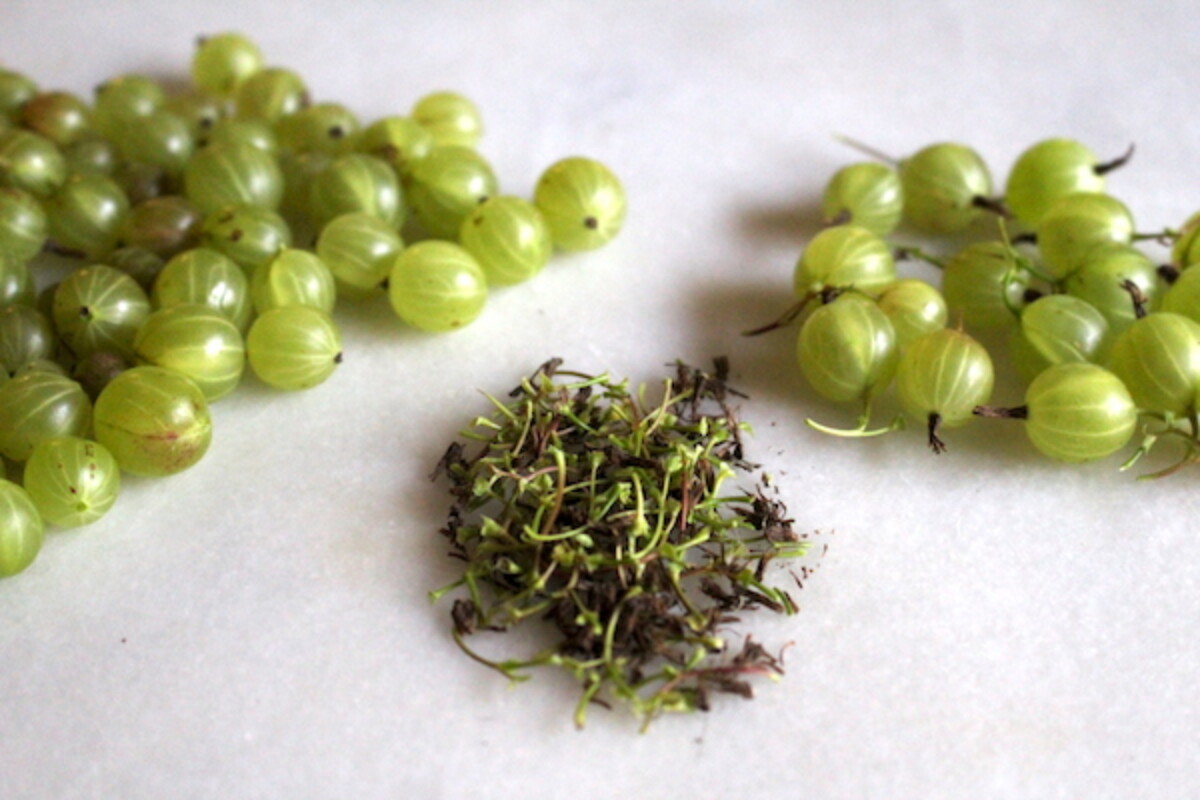
Once the gooseberries are cleaned, weigh the fruit. If you don’t have a kitchen scale, you can just measure. It takes about 3 cups of gooseberries to make 1 pound, so each cup weighs roughly 1/3 lb.
Place them into a pot with a bit of water and a splash of lemon or lime juice. The lemon juice is optional, and not necessary for canning or refrigerator jams, but it really brings out the flavor in the finished gooseberry jam. I personally like lime juice, and I think it works well with the green gooseberries.
Turn the heat to medium-high and cook, stirring often until the gooseberries disintegrate (about 5 minutes). While the gooseberries are cooking, weigh out your sugar.
Gooseberries are a tart fruit, and while I’m usually a fan of low sugar jams, I’m not skimping here. Most recipes for gooseberry jam call for somewhere between 3/4 and 1 pound of sugar for every pound of fruit.
Again, if you don’t have a kitchen scale, no worries. One pound of granulated sugar is roughly 2 cups, so add 1 1/2 to 2 cups of sugar for every 3 cups of gooseberries.
Bring the pot back to a rapid boil, and cook for about 8 to 10 minutes until the mixture reaches gel stage. You can test this with a kitchen thermometer (220 degrees F) or you can place a plate in the freezer and test a small spoonful of jam on the plate. It should gel when it hits the cold plate if it’s done.
I, of course, just to be contrary, don’t use either of these methods. I dip a spoon into the pot and pour it back in. The gooseberry jam is finished when it begins to “sheet” off the spoon rather than drip.
There are other signs too, if you’re an experienced jam maker you know that the bubbles change in texture as a jam reaches gel stage, and they become glossier and slower to pop. There’s an abrupt change that you can see if you really watch for it.
Once your gooseberry jam reaches gel stage, pour it into prepared jars leaving 1/4 inch headspace. It’ll keep in the fridge for weeks, or you can process the jars in a water bath canner for 10 minutes and it’ll be shelf-stable for years.
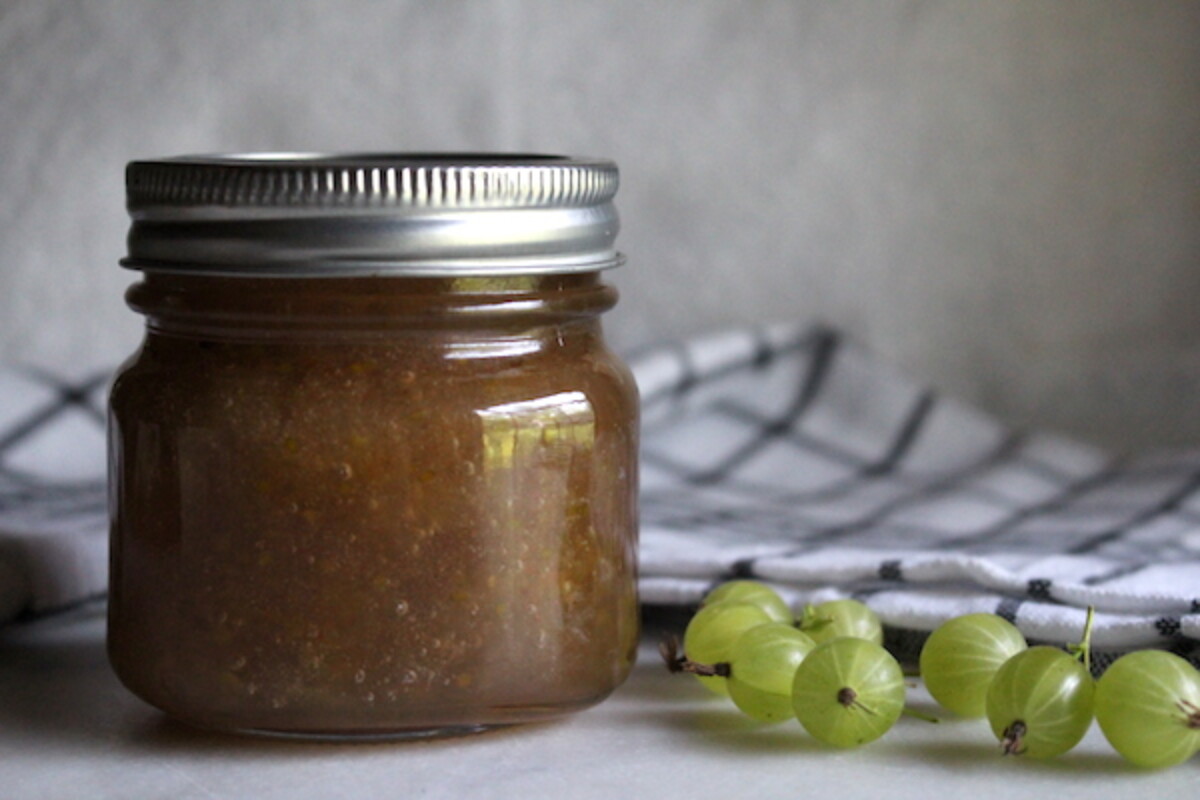
Gooseberry Jam Variations
I’m loving my simple gooseberry jam, but I’ve also found a few options for you if you have a bumper crop on hand and want to get creative. This is what I get for researching gooseberry jam recipes before I had the fruit in hand…
- With Gin ~ Combining two British favorites, the juniper in gin goes really well with gooseberries. I’ve had gooseberry-infused gin and it was amazing, I can only imagine how it works in reverse.
- With Fresh Elderflower ~ Our elderflowers just popped into bloom this week, which coincides perfectly with gooseberry season. Elderflower jams are wonderful, and you can add those tiny blossoms to all manner of fruit jams…like this strawberry elderflower jam for example.
- With Rhubarb ~ It’s the tail end of our rhubarb season here in the north country, and things are just heating up. Earlier in the season, I made both a strawberry rhubarb jam and a straight rhubarb jam. I was looking forward to a rhubarb gooseberry jam with the last rhubarb harvest of the season, but that’ll have to wait until next year.
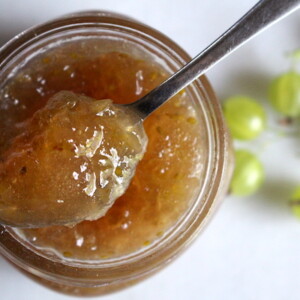
Gooseberry Jam
Ingredients
- 1 lb Gooseberries, about 3 cups per pound
- 3/4 to 1 lb sugar, about 2 cups per pound
- 1/4 cup water
- 1-2 Tbsp Lemon Juice, Optional
Instructions
- Clean the gooseberries by removing their tops and tails.
- Place the cleaned gooseberries into a pot with the water and lemon juice. Bring them to a boil over medium-high heat, and cook until they’ve disintegrated (about 5 minutes).
- Add the sugar, and boil the mixture hard until it reaches gel stage, about 8-10 minutes. Test the jam on a plate in the freezer, or check to see if it sheets off a spoon. Alternately, use a food thermometer and wait until it reaches 220 degrees F.
- Pour the gooseberry jam into prepared jars, leaving 1/4 inch headspace. Apply 2 part canning lids and seal finger tight.
- Either store the jars in the refrigerator for immediate use, or process in a water bath canner for 10 minutes for a shelf stable home canned gooseberry jam that will last years at room temperature.
Notes
Nutrition
Nutrition information is automatically calculated, so should only be used as an approximation.
More Summer Jam Recipes
Looking for more easy canning recipes? I have over 100 on the site, but here are a few more fun jams to get you started:
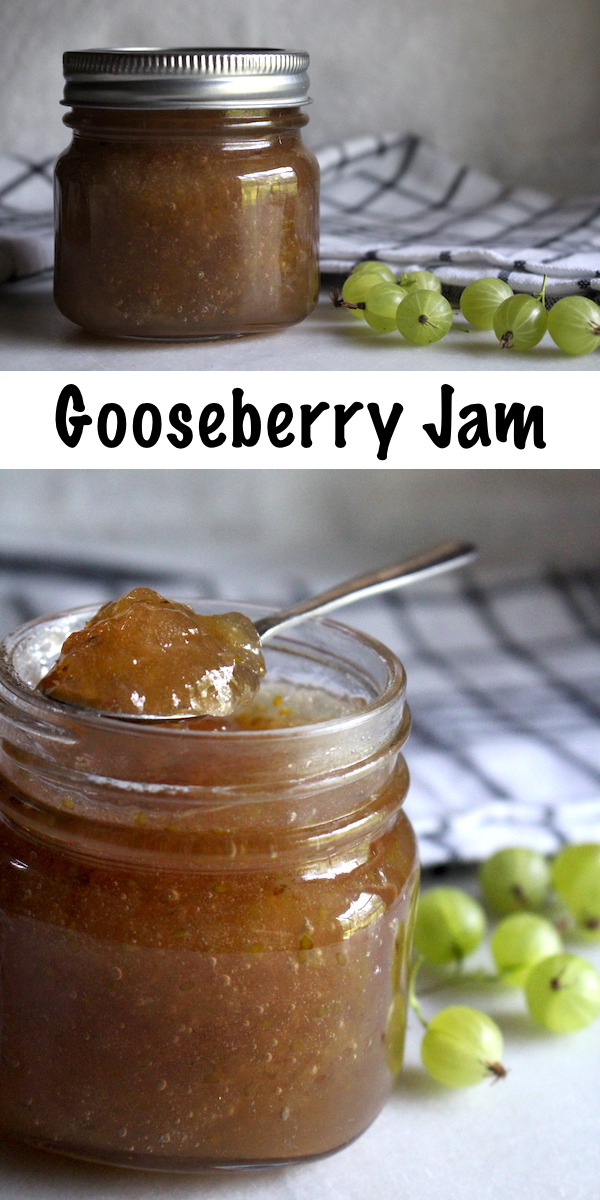

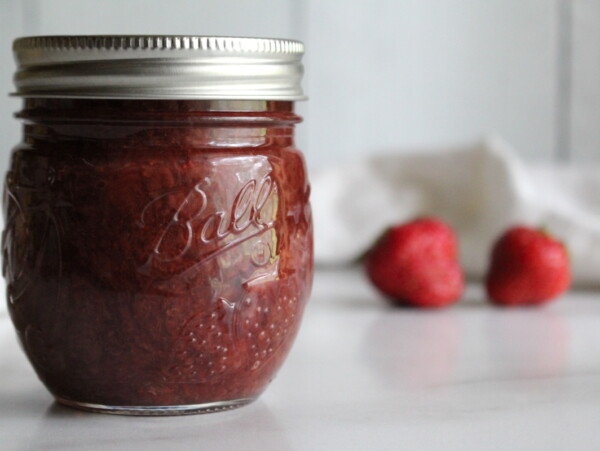












Just made this! It was supposed to be for holiday gifts but we may eat it all before that… lol!
Im at 4, 502′ elevation so my gel point is 212°F.
I added a bit more lemon juice because I prefer the tart balance to the excess sweetener.
Awesome recipe and easy to follow!
Wonderful, so glad you enjoyed it!
I make gooseberry jam just using gooseberry and honey, with a little water, and can it and water bath for 15 minutes and it last well over a year. Going to do a batch tomorrow, gooseberry’s all ready cleaned. To me cleaning them is very time consuming, The rest is easy. I still have some jars from last year, so will be more generous with it this year, mostly save it for special occasions. It is my favorite jam, love it over whole wheat blueberry pancakes, and toping on ice cream, also great on home made bread.
Wonderful!
Because I am considered pre-diabetic, I’m wondering if the sugar is necessary for the consistency, ability to gel or just as flavoring. I would prefer to use monk fruit or some such that would not raise blood sugar. I have ten to fifteen gooseberry plants around, and although they haven’t started fruiting in earnest yet, like you, I want to be prepared! Thanks.
The sugar in this recipe is required to get the jam to set, so yes, it’s for consistency. If you use monkfruit or something else, it wont set. But, you can make the recipe using a no sugar added pectin (like sure jel low sugar). In that case, use monkfruit and then follow their recipe for sour cherry jam.
This is a great help. Thank you!
I use only gooseberries and honey and it sets no problem, I do test it using a cold plate and spoon before bottling. Stays good for over a year.
Sounds great! Do you have a recipe for ground cherry jam also?
Sure do! https://practicalselfreliance.com/ground-cherry-jam/
If I ever harvested more than a handful I’d be very pleased. I have come up with a jam with most of the fruits I never have enough of; “Joel” bush cherry, Black Aronia & Ground Cherries, with a touch of red wine. It’s quite good. I use “Pamona’s Pectin”, so I can use only a small amount of sugar.
I also have a mini sour cherry tree called “Carmine Jewel”, with beautiful glowing ruby-like fruit, really produces for its
tiny size. I mix them with a touch of vanilla & cinnamon. Delicious! I get bored eating single fruit jams, so I make
“Blue-Barb”, “Black & Blue Berry”, “Red/Black Rasp.”, “Strawberry/Rhubarb” &”Cinna-Blue Wine”. This year a had a good crop of “Swamp” (wild) Gooseberries, that are waiting in the freezer. Wonder what I’ll mix those with?
Those all sound amazing. I would love to hear what you decide to mix with the Swamp gooseberries.
Hi! I live in Greensboro Bend, in the wonderful Northeast Kingdom of Vermont & today was gooseberry picking day.
My gooseberries were dubbed the “Old Outhouse” gooseberries, when we found the bush growing out from under where the old outhouse had been. I think they are known as swamp or wild gooseberries, turn wine color, are sweet & tasty, but they have SPINES! Raw, I just crush them with my back teeth, carefully & get rid of the leftover skin. Do you know whether the spines will dissolve during cooking? My red raspberries didn’t do well this year & they usually make up 1/3 of the total fruit I use/combine to make jam, with my blueberries, black raspberries & rhubarb. (Try “BlueBarb” jam. It’s great! ) I made 79 jars of assorted jams, last year, so I’m hoping the gooseberries will be able to fill-in a bit, this year.
Cooking should soften the spines. I have also read that if they are ripe, the spines can easily be rubbed off.
Thanks!
You’re welcome.
Well, I must say I enjoyed reading your (wait is this a blog?) well whatever you call it I enjoyed reading it. I don’t have any gooseberries so I won’t be making any jam. I loved the imagery of your son watching over the berries. Thank you for sharing.
You’re very welcome. So glad you’re enjoying the blog.
Can I make a seedless and skinless jelly use this recipe if I strain it before canning? We have tons of berries and don’t have time to remove all the stems and flowers.
Yes, a jelly would work just fine.
I love Gooseberries, in pies, etc. This is my first try at jam. The mixture was perfect and the flavor was good, but sharp, I am not a sugar user by great volume, and I wanted to temper the mixture with “something”, so I added a slightly crushed fresh Sage leaf and cooked and stirred until the leaf was perfectly limp. Removed the leave and cooked until it was more thickened, and tasted it. So good,and with just a hint of “something”.
That’s very interesting. Thanks for sharing.
Are you suppose to mash the berries?
There is no need to mash them. As you cook and stir them they should disintegrate on their own.
Can gooseberry jam be made in a bread machine? Would the measurements be the same? Thank you!
Does your bread machine have a specific setting for jam?
Can the filled jars be frozen?
Yes. To make a freezer jam though, you need to use freezer-safe jars. They’re usually straight-sided, like the ball wide mouth pint jars, or quilted half-pints. For a freezer jam in a freezer-safe jar, leave more headspace to allow for expansion (no need to use the 1/4 inch headspace, as that’s just for canning).
We have crews buried bushes growing at my mother’s house like weeds. I noticed this spring they were covered in blossoms and have been watching them all summer waiting for them to ripen. We also ran into the problem of the birds beating me to them but I did manage to get six cups picked. I can remember my grandma and my mom making gooseberry jam years ago and I decided to give it a try. I was so glad I found your site and your recipe, it was very helpful! It turned out fabulous!! Absolutely delicious! We have an abundance of apples and grapes so I’m going to give the crock pot apple butter recipe a try! Thank you!!
Wonderful!
Nice recipe but for some reason i only got 1 pint of jam.
I followed recipe exactly.
Gooseberries can vary a bit in terms of juiciness and pectin content (like any fruit), which will cause the yield to vary slightly. This recipe makes 3 half-pint jars (or 1 1/2 pints) generally, so getting 1 pint isn’t too far off.
Had 2 1/2 LBS gooseberries in the freezer for 3 (?) yrs! Made this jam exactly as the recipe calls for……awesome! Thank you! Grew up with gooseberry everything, big plump berries, that my parents planted on their farm in Ireland. They are very hard to find in S.W. Ontario. Very small berries, not sure if bigger berries would grow here due to the climate.
very simple receipe, highlights the berries. i used lemon juice as suggested.
Hi, I’ve made this twice and both times had the same problem. By the time it passed the gel test (I didn’t want runny jam) everything seemed fine. But when it cooled after the water bath it’s practically a brick. All I can think to do is cook it for less time but it’s really a guess of when to stop boiling then. I boiled it less time than the recipe called for as is. Any ideas? It is delicious, just not very spreadable.
I’d suggest using an instant-read thermometer to test for gelling if you’re having issues. The gel point is 220F at sea level, and 1 degree less for every 500 feet above. (For example, at 1000 feet the gel point is 218.) I find that to be a more reliable method than a gel test most the time. Best of luck!
A year later, the neighbour’s gooseberries are ripe again, and so I’m trying again. I did two very small batches (1 cup berries each) to experiment and think I’ve figured out what works for these berries. They’re the red kind (the ripe berries look black) and must have an amazing amount of pectin. I add water at 4:1 ratio and just boiled hard for 1 minute. Set is quite firm but not a brick now. Thanks for the recipe!